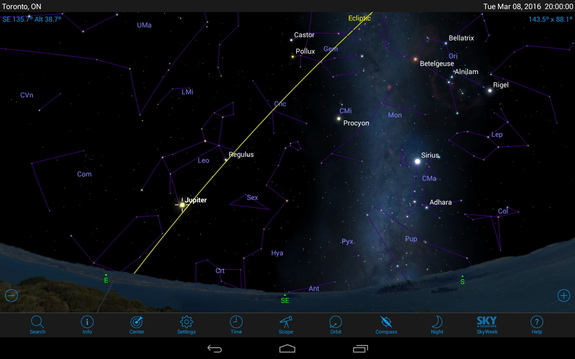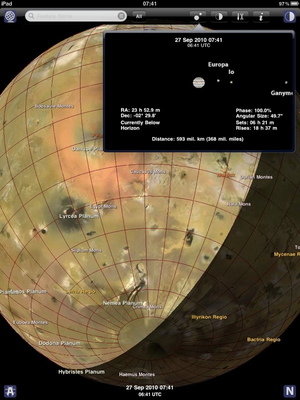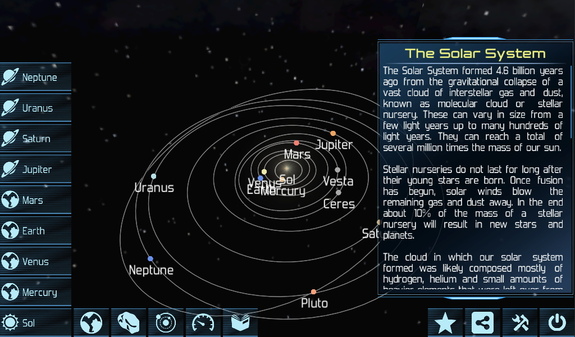This week, Jupiter, the king of planets, reaches opposition — the day of the year when Earth’s orbit carries it the closest to the giant planet. Currently, Jupiter rises as the sun sets, and the planet traverses the sky all night.
In your binoculars or telescope , Jupiter will appear with a disk diameter of 44.5 arc seconds (about 2 percent of the full moon’s diameter). That’s nearly as large as Jupiter ever appears. There’s no better time to install some apps to help you locate it, track the motion of the four Galilean moons , find out when the Great Red Spot is visible and learn some Jovian science! [Watch: Jupiter and Its Moons Are a Celestial Spring Treat ]
Finding Jupiter
Despite Jupiter’s great distance, the planet’s size reflects a lot of sunlight, making it second only to Venus in brightness among the planets, and outshining every star in the night sky. In March 2016, Jupiter is sitting below the stars of Leo in the eastern evening sky. Your favorite sky-charting app (SkySafari 5 , Star Walk 2 , Sky Guide , Stellarium , Star Chart , Google Sky Map , etc.) will have no problem confirming this for you on your mobile device. By July 2016, Jupiter will appear low in the western evening sky, soon becoming too close to the sun to be observable. If you push the date forward on your app, it will show you that Jupiter becomes a morning object in late fall

Planets are always found near the Ecliptic, the imaginary line shown in yellow that marks the plane of our solar system.
Credit: SkySafari App for iOS and Android
Spotting the Great Red Spot
The famous Great Red Spot (or GRS) is a cyclonic storm that has been raging on Jupiter for at least 185 years. A persistent spot on Jupiter was reported even earlier, by Giovanni Cassini from 1665 to 1713, but no one is sure whether that was the same one we see today. The Great Red Spot’s oval is large enough to hold several Earths, making it visible in backyard telescopes ! Jupiter rotates quite quickly — once on its axis every 10 hours — and the spot takes about 3 hours to traverse the planet’s disk. As a result, the spot is not visible every night. A mobile app is a perfect way to find out whether it’s visible now, or when it will be.
Most sky-charting apps show Jupiter as a photographic image with the red spot visible, but this might fool you into thinking it’s always there. The better apps present Jupiter as a complete globe that rotates at the correct rate. As long as your app is set to the current time, it will show Jupiter as it appears in your telescope right now. But there’s a catch. Jupiter is far enough away (more than 600 million kilometers, or 370 million miles) that we don’t see events in real time. The light needs time to travel all the way to Earth. It varies through the year, but right now, it’s delayed by about 36 minutes. The SkySafari app has an algorithm that corrects for this, but most of the other sky-charting apps I tested did not.
Another option is to choose an app that focuses exclusively on Jupiter. Sky and Telescope has a very good app for iOS called JupiterMoons (developed by the SkySafari app team). It allows you to view the planet’s current appearance and move forward and backward in time, in increments ranging from seconds to years. A separate page provides a list of upcoming GRS transits in local time, and another offers plenty of Jupiter facts and figures.
Galileo’s moons
Jupiter has more than 60 natural satellites , or moons — mainly, small objects that have been trapped by the massive planet’s gravity. The four largest moons were first observed by Galileo Galilei in 1609 using a very modest telescope. By observing the moons nightly over a period of weeks, he discovered that they were orbiting Jupiter — a controversial statement in his day!
Astronomers commonly refer to the big four as the Galilean moons. From closest to farthest from Jupiter, they are Io, Europa, Ganymede and Callisto . Close-in Io moves faster than the outer ones, needing only 1.8 days to orbit Jupiter, while distant Callisto takes nearly 17 days. Even modern-day binoculars are better than Galileo’s little spyglass, so you can look for them yourself! Unlike the Earth’s axis, which is tilted with respect to the solar system plane, Jupiter sits up straight, so the Galilean moons fall somewhere on a straight line that runs parallel to the planet’s equator. Their differing orbital speeds produce different arrangements of the moons: close together, well separated, arranged symmetrically and sometimes all clumped to the left or right (east or west) side of Jupiter.
It usually takes only a short while to notice the moons shifting in position. Your sky-charting app will have at least the four Galilean moons labeled, and perhaps some additional fainter ones. For iOS users, the Jupiter Guide app , the Gas Giants app and the Sky & Tel app noted above all show a clear view of the arrangement of the planet and the moons, and offer a slider or buttons to alter the time. Unlike binoculars, most telescopes will invert or mirror image your view of Jupiter. Some of the apps allow you to select the mode that matches your equipment. Because the moons seldom line up symmetrically, it’s simple to compare what you are observing in your eyepiece with the app, and configure the flip buttons until it’s the same.
Our line of sight to Jupiter also means that the moons can transit (or cross) the planet; disappear or emerge from behind it (occultations); or even pass in front of one another! While the moons themselves are difficult to see while transiting Jupiter, their little round, black shadows are easy to see in a decent telescope. You just need to know when to look! Other than SkySafari 5, most of the above apps will not show you the shadows on the planet, but if your app says a moon is transiting, it’s worth looking for a shadow. When planning to observe, you can run the time forward on the app to discover when the other types of events will occur. The Jupiter system runs like clockwork, so we can accurately predict events far into the future. This month, there will be half a dozen times when two moons and shadows will be transiting at once! Your app will tell you which ones are visible where you live.
The Gas Giants app has an extensive menu of commercial telescope brands and models, as well as popular eyepieces, that you can use to match your setup, including the telescope image flipping. Then, the app shows you exactly what you should see in your telescope.
Beyond observing
The Galilean moons are worlds unto themselves — massive enough to have geologic activity, interesting terrain and even thin atmospheres! They contain a great deal of water ice and other volatiles left over from the formation of the solar system. The tidal stresses produced by mutual gravitation have kept their interiors warm enough for active volcanoes on Io and for liquid saltwater oceans to form beneath the icy crusts of Europa and Ganymede!
The Jupiter Atlas app for iOS provides labeled globes for each Galilean moon, complete with high-resolution imagery and coordinate grids. By touching the globe icon in the upper-left corner, you can switch from a fixed view to a dynamic one, where you can rotate and zoom in and out. There’s a searchable index of the named features on each object, so you can explore the sulfur volcanoes of Io , named for fire and thunder deities from Earth’s cultures; the icy plates of Europa; and the craters of Callisto, each named from Norse mythology.

Using the Jupiter Atlas app for iOS, explore the surfaces of Jupiter’s Galilean moons and the arrangement of the Jupiter system on any time and date.
Credit: LunarDevelopment for iOS
A double tap on each feature brings up information about its size and the origin or meaning of its name. You can also enable a mode that shows the phases of the moons, indicating which parts are in sunlight and which are in shadow. There’s an option to see Jupiter’s current appearance, and if you run the app in landscape mode, you’ll see the planet and the arrangement of the moons. The app works in real time or with manually entered times and dates.
Jupiter’s enormous magnetic field generates a strong radio signal that can be picked up by radio enthusiasts. The Jupiter Radio Map app for iOS facilitates this. It is one of the contributions to the NASA Radio JOVE project. At http://radiojove.gsfc.nasa.gov , you will find more educational materials about Jupiter’s radio emissions.
For a great app that lets you experience Jupiter and dozens of other planets, moons and major asteroids like an interplanetary traveler, check out the Solar System Explorer HD app for Android. It lets you fly around the solar system, visit each realistically 3D-rendered object (complete with shadows) and call up interesting science about it. It also lets you peer into the interior of the planets, and pull back and see the entire solar system in action — showing the orbits with a time slider to run forward and backward. The app comes in a free version with ads and an ad-free paid version that includes some additional content.

The Solar Explorer HD app for Android lets you fly around the solar system and explore all the major bodies in realistically rendered 3D or pull back and watch the whole thing work.
Credit: Burlock.org for Android
Close-up imagery of Jupiter is breathtaking, and there are plenty of wallpaper apps to decorate your device, courtesy of several planetary exploration missions like Voyager, Pioneer and Galileo. And while you’re out under the stars, why not load your device with Gustav Holst’s classical piece “The Planets” and have a listen. Each planet has its own theme. Jupiter’s is “Bringer of Jollity”! From the armchair voyager to the serious scientist, there’s an app for every level of expertise. From time to time as more are released, we’ll take a look.
In our next column, we’ll look at spotting satellite flashes and spotting the International Space Station. Satellite tracking capable apps are your tour guide to the hundreds of satellites that humanity has launched into orbit — where to find them in the sky, when they’ll pass overhead and where they are orbiting over Earth right now. These apps can show you the spacecraft that will pass over your location at any given time. You can even get a “bird’s-eye view” from a satellite itself and see the Earth from orbit exactly as the satellite sees it! Best of all, you can get notification alerts directly on your mobile device, ensuring you will never miss a bright satellite going overhead. Until next time — keep looking up!
Editor‘s note: Chris Vaughan is an astronomy public outreach and education specialist, and operator of the historic 1.88-meter David Dunlap Observatory telescope. You can reach Vaughan via email, and follow him on Twitter @astrogeoguy , as well as Facebook and Tumblr .
This article was provided by Simulation Curriculum , the leader in space science curriculum solutions and the makers of the SkySafari app for Android and iOS. Follow SkySafari on Twitter @SkySafariAstro . Follow us @Spacedotcom , Facebook and Google+ . Original article on Space.com .


Comments are closed.